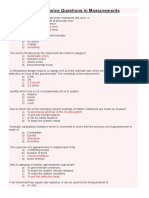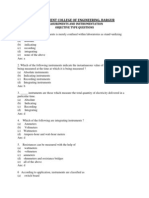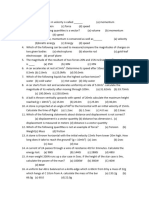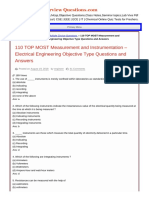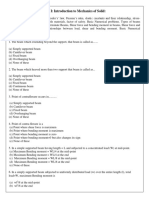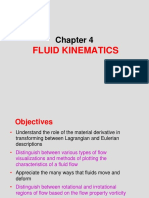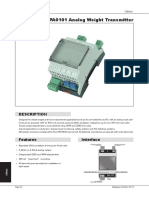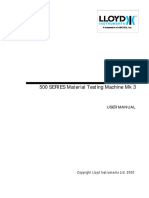Sheet 5 Ans
Sheet 5 Ans
Uploaded by
Aya HassanCopyright:
Available Formats
Sheet 5 Ans
Sheet 5 Ans
Uploaded by
Aya HassanOriginal Title
Copyright
Available Formats
Share this document
Did you find this document useful?
Is this content inappropriate?
Copyright:
Available Formats
Sheet 5 Ans
Sheet 5 Ans
Uploaded by
Aya HassanCopyright:
Available Formats
Benha University Faculty of Engineering at Shoubra Mechanical Engineering Department
First Semester 2023/2024 2nd Year
Theory of Measurements and Sensors (Cod MEC201) Assignment no. (5)
Que 1. MULTIPLE-CHOICE QUESTIONS
1. Strain gauge rosettes are used when the direction of the
(a) principal stress is unknown
(b) hoop stress is known
(c) principal stress is known
(d) hoop stress is unknown
2. Dummy strain gauge are used for
(a) bridge sensitivity enhancement
(b) temperature compensation
(c) determining gauge factor
(d) calibration of strain gauges
3. Strain gauges cannot be used at high temperatures because of
(a) inferior strain gauge materials
(b) gauge not being properly welded
(c) a problem with gauge factor
(d) decomposition of cement and carrier materials
4. Which of the following equations is correct?
5. In a platform balance, the unknown weight is placed at
(a) a specified position only
(b) any position with certain conditions
(c) any position without any conditions
(d) a corner only
6. Buoyancy effects are found in
(a) platform balance
(b) analytical balance
(c) electromagnetic-type balance
(d) pendulum-type balance
7. Which of the following balances is not appropriate for large weights?
(a) Analytical balance
(b) Platform balance
(c) Electromagnetic-type balance
(d) Pendulum-type balance
8. When an elastic member is used in conjunction with a strain gauge, it is called a
(a) proving ring
(b) absorption dynamometer
(c) Prony brake
(d) load cell
9. Tape recordings are used in
(a) servo-controlled dynamometers
(b) torsion-bar dynamometer
(c) Prony brake dynamometer
(d) piezoelectric transducers
10. In servo-controlled dynamometers,
(a) speed is controlled
(b) torque is controlled
(c) both speed and torque are controlled
(d) strain is controlled
11. In a Prony brake dynamometer,
(a) mechanical energy is converted into heat
(b) mechanical energy is converted into electrical energy
(c) electrical energy is converted into torque
(d) there is no need for energy conversion
12. In a p-type semiconductor gauge, as tensile strain increases
(a) gauge resistance decreases
(b) gauge resistance increases
(c) gauge resistance increases and then decreases
(d) there is no effect on gauge resistance
13. In torsion-bar dynamometers, deflection measurement is carried out by
(a) mechanical methods
(b) electrical methods
(c) electronic methods
(d) optical methods
14. In torsion-bar dynamometers, to read the deflection of the rotating shaft
(a) hygroscopic effect is used
(b) telescopic effect is used
(c) stroboscopic effect is used
(d) microscopic effect is used
15. Which of the following device can be used for force measurement?
a) Beams
b) Bellows
c) Capsule
d) Bourdon tube
16. Which of the following can be measured using a Ring-type load cell?
a) Large weight
b) Small weight
c) Both large and small weights
d) None of the mentioned
17. Which of the following arrangements are used in load cells?
a) Tensile strain gauges
b) Compressive strain gauges
c) Both tensile and compressive strain gauges
d) None of the mentioned
18. Which of the following conversion is correct for load cell?
a) Force to strain
b) Force to displacement
c) Force to voltage
d) Both force to strain and force to displacement
19. Strain gauges can be used to measure
1. Tension
2. Compression
3. Both of these
4. None of these
20. The ___________ of a strain gauge varies with applied strain.
1. resistance
2. capacitance
3. inductance
4. flux
21. Bonding element in a strain gauge must have __________
1. zero insulation resistance
2. low insulation resistance
3. high insulation resistance
4. infinite insulation resistance
22. ________ is used to detect very small changes in resistance of strain gauges.
1. Maxwell’s bridge
2. Wheatstone bridge
3. Anderson bridge
4. Schering Bridge
23. Compute the gauge factor if change is resistance is 0.2Ω per Ohm and change in length is 0.6 per meter.
1. 0.33
2. 0.6
3. 0.2
4. 3
24. A single strain gauge of resistance 120 Ω is mounted along the axial direction of an axially loaded
specimen of steel (E = 200 GPa). The percentage change in length of the rod due to loading is 3% and the
corresponding change in resistivity of strain gauge material is 0.3%, For a Poisson's ratio of 0.3, the value
of the gauge factor is
1. 1.3
2. 1.5
3. 1.7
4. 2.0
25. Which of the following strain gauge material has the highest value of gauge factor?
(a) Constantan (b) Soft iron (c) Platinum (d) Semiconductor
26. A strain gauge material should have low
(c) Resistance
(a) Gauge factor (b) Sensitivity temperature (d) All of the above
coefficient
27.In measurements using two strain gauges, the purpose of dummy strain gauge is
(b) Improve
(a) To nullify the (d) Increase the
stability of
(c) Measure lateral sensitivity of
errors due to the
strain measuring
temperature measuring
system
system
28.A load cell is essentially a
(c) Photoconductive (d) Strain
(a) Thermocouple (b) Thermistor
device gauge
29.A load cell cannot be used to measure.
(d) All of the
(a) Weight (b) Temperature (c) Pressure
above
Que 2.
Determine the total resistance of a copper wire having a diameter of 1 mm and a length of 5 cm.
The resistivity of copper is 1.7 × 10-8 Ω-m.
Que 3.
A very common material for the construction of strain gauges is the alloy constantan (55% copper with
45% nickel), which has a resistivity of 49 × 10-8 Ω-m. A typical strain gauge might have a resistance of 120
Ω. What length of constantan wire of diameter 0.025 mm would yield a resistance of 120 Ω?
Que 4.
A strain gauge, having a gauge factor of 2, is mounted on a rectangular steel bar (Em = 200 × 106 kN/m2).
The bar is 3 cm wide and 1 cm high and is subjected to a tensile force of 30 kN. Determine the resistance
change of the strain gauge if the resistance of the gauge was 120 Ω in the absence of the axial load.
With Best Wishes
You might also like
- Measurement Instrumentation Objective Questions Answers 02No ratings yetMeasurement Instrumentation Objective Questions Answers 022 pages
- CUET Memory Based Physics Question Paper 2023 21may2023No ratings yetCUET Memory Based Physics Question Paper 2023 21may202311 pages
- Multiple Choice Questions in Measurements: C) Less Than Full-Scale ErrorNo ratings yetMultiple Choice Questions in Measurements: C) Less Than Full-Scale Error4 pages
- Electrical-and-Electronics-Measurement-MCQ-2No ratings yetElectrical-and-Electronics-Measurement-MCQ-229 pages
- Pc-Ee403-Mcq Type Questions With Answer PDFNo ratings yetPc-Ee403-Mcq Type Questions With Answer PDF13 pages
- HT TP: //qpa Pe R.W But .Ac .In: CS / B.TECH (FT) / SEM-6 / ET-601/ 2011No ratings yetHT TP: //qpa Pe R.W But .Ac .In: CS / B.TECH (FT) / SEM-6 / ET-601/ 20117 pages
- Measurements and Instrumentation Objective Type Questions67% (3)Measurements and Instrumentation Objective Type Questions18 pages
- TNEB AE Mechanical Engineer Solved Model Paper 5 PDFNo ratings yetTNEB AE Mechanical Engineer Solved Model Paper 5 PDF27 pages
- Electrical Measuring Instruments MCQ PDFNo ratings yetElectrical Measuring Instruments MCQ PDF27 pages
- CHEMICAL ENGINEERING OBJECTIVE TYPE QUESTIONS Instrumentation and Process Control PDF0% (1)CHEMICAL ENGINEERING OBJECTIVE TYPE QUESTIONS Instrumentation and Process Control PDF15 pages
- 160 Instruments and Measurements Mcqs With Answers100% (1)160 Instruments and Measurements Mcqs With Answers19 pages
- Mechanical Engineering Model Exit Exam Q&ANo ratings yetMechanical Engineering Model Exit Exam Q&A20 pages
- Chapter 1 Physical Quantities and Units RevisionNo ratings yetChapter 1 Physical Quantities and Units Revision7 pages
- Cet308 Comprehensive Course Work May 2024No ratings yetCet308 Comprehensive Course Work May 20244 pages
- Electrical Measurements and Instrumentation: Multiple Choice Questions OnNo ratings yetElectrical Measurements and Instrumentation: Multiple Choice Questions On51 pages
- 352 12865 EC530 2011 4 2 1 Ec530 - mcq07No ratings yet352 12865 EC530 2011 4 2 1 Ec530 - mcq073 pages
- 110 TOP MOST Measurement and Instrumentation - Electrical Engineering Objective Type Questions and AnswersNo ratings yet110 TOP MOST Measurement and Instrumentation - Electrical Engineering Objective Type Questions and Answers22 pages
- Question Bank: Dr. Navalar Nedunchezhiyan College of EngineeringNo ratings yetQuestion Bank: Dr. Navalar Nedunchezhiyan College of Engineering11 pages
- Megger Is An Instrument Used For The Measurement of A) High Resistance and Insulation Resistance B) Medium Resistance C) Low Resistance D) Leakage Current 3No ratings yetMegger Is An Instrument Used For The Measurement of A) High Resistance and Insulation Resistance B) Medium Resistance C) Low Resistance D) Leakage Current 39 pages
- Unit I: Introduction To Mechanics of Solid100% (1)Unit I: Introduction To Mechanics of Solid26 pages
- Class 11 JEE Based Unit and Dimensions TestNo ratings yetClass 11 JEE Based Unit and Dimensions Test2 pages
- Structural Dynamics Multiple Choice Questions100% (3)Structural Dynamics Multiple Choice Questions3 pages
- Practice Questions On Experiments (1-4) (1) .PDFNo ratings yetPractice Questions On Experiments (1-4) (1) .PDF9 pages
- Sheet (1) : (A) Red, Violet, Orange, Gold (B) Brown, Gray, Red, SilverNo ratings yetSheet (1) : (A) Red, Violet, Orange, Gold (B) Brown, Gray, Red, Silver2 pages
- Modeling Simulation and Control of Half PDFNo ratings yetModeling Simulation and Control of Half PDF12 pages
- Thermal Energy Storage in Molten Salts: Overview of Novel Concepts and The DLR Test Facility TESISNo ratings yetThermal Energy Storage in Molten Salts: Overview of Novel Concepts and The DLR Test Facility TESIS10 pages
- Molten Salt Reactors (Pres. Slides) - ORNL (2002)No ratings yetMolten Salt Reactors (Pres. Slides) - ORNL (2002)20 pages
- Equivalent Mass, Stiffness, and Loading For Off-Centre Missile Impact EvaluationsNo ratings yetEquivalent Mass, Stiffness, and Loading For Off-Centre Missile Impact Evaluations10 pages
- Compost Processing Machine - ETP G5 SEPT 19 Extended ProposalNo ratings yetCompost Processing Machine - ETP G5 SEPT 19 Extended Proposal25 pages
- Load Management System Edgevision: Operator ManualNo ratings yetLoad Management System Edgevision: Operator Manual27 pages
- 2019-Wearable, Ultrawide-Range, and Bending-Insensitive Pressure Sensor Based On Carbon Nanotube Network-Coated Porous Elastomer Sponges For Human Interface and Healthcare DevicesNo ratings yet2019-Wearable, Ultrawide-Range, and Bending-Insensitive Pressure Sensor Based On Carbon Nanotube Network-Coated Porous Elastomer Sponges For Human Interface and Healthcare Devices10 pages
- ISO 376 Guidance and Uncertainty Measurements Relating To Force EquipmentNo ratings yetISO 376 Guidance and Uncertainty Measurements Relating To Force Equipment28 pages
- 44098237 B MAR HB System Handbook WeighModule EnNo ratings yet44098237 B MAR HB System Handbook WeighModule En144 pages
- Force Plate Usein Performance Monitoringand Sport Science TestingNo ratings yetForce Plate Usein Performance Monitoringand Sport Science Testing14 pages
- 24.concepts of Feeder Design and Performance in Relation To Loading Bulk Solids Onto Conveyor BeltsNo ratings yet24.concepts of Feeder Design and Performance in Relation To Loading Bulk Solids Onto Conveyor Belts35 pages
- Benefits of Die-Wall Instrumentation For Research and Development in TablettingNo ratings yetBenefits of Die-Wall Instrumentation For Research and Development in Tabletting18 pages
- Transcell: LCT6-RPA0101 Analog Weight TransmitterNo ratings yetTranscell: LCT6-RPA0101 Analog Weight Transmitter2 pages
- Tlu - Tluana: Installation and User ManualNo ratings yetTlu - Tluana: Installation and User Manual43 pages
- Tension Control System XCTRL & Xctrl-2Drv: Installation and Operation ManualNo ratings yetTension Control System XCTRL & Xctrl-2Drv: Installation and Operation Manual38 pages
- This Set of Instrumentation Transducers Multiple Choice Questions67% (6)This Set of Instrumentation Transducers Multiple Choice Questions18 pages
- Systel Instrumentation Services Private Limited: EmailNo ratings yetSystel Instrumentation Services Private Limited: Email13 pages
- Subject: Offer For AMW Make ACB 60 Concrete Batching Plant: To, DATE:-03/06/2021 M/S SheikhbhaiNo ratings yetSubject: Offer For AMW Make ACB 60 Concrete Batching Plant: To, DATE:-03/06/2021 M/S Sheikhbhai5 pages
- Heat Sealer Repair and Maintenance Kit IFU 2019-02-06No ratings yetHeat Sealer Repair and Maintenance Kit IFU 2019-02-0627 pages
- MAIN DIFFERENCES Between TS44 and TFS Rev5No ratings yetMAIN DIFFERENCES Between TS44 and TFS Rev53 pages
- Measurement Instrumentation Objective Questions Answers 02Measurement Instrumentation Objective Questions Answers 02
- CUET Memory Based Physics Question Paper 2023 21may2023CUET Memory Based Physics Question Paper 2023 21may2023
- Multiple Choice Questions in Measurements: C) Less Than Full-Scale ErrorMultiple Choice Questions in Measurements: C) Less Than Full-Scale Error
- HT TP: //qpa Pe R.W But .Ac .In: CS / B.TECH (FT) / SEM-6 / ET-601/ 2011HT TP: //qpa Pe R.W But .Ac .In: CS / B.TECH (FT) / SEM-6 / ET-601/ 2011
- Measurements and Instrumentation Objective Type QuestionsMeasurements and Instrumentation Objective Type Questions
- TNEB AE Mechanical Engineer Solved Model Paper 5 PDFTNEB AE Mechanical Engineer Solved Model Paper 5 PDF
- CHEMICAL ENGINEERING OBJECTIVE TYPE QUESTIONS Instrumentation and Process Control PDFCHEMICAL ENGINEERING OBJECTIVE TYPE QUESTIONS Instrumentation and Process Control PDF
- 160 Instruments and Measurements Mcqs With Answers160 Instruments and Measurements Mcqs With Answers
- Electrical Measurements and Instrumentation: Multiple Choice Questions OnElectrical Measurements and Instrumentation: Multiple Choice Questions On
- 110 TOP MOST Measurement and Instrumentation - Electrical Engineering Objective Type Questions and Answers110 TOP MOST Measurement and Instrumentation - Electrical Engineering Objective Type Questions and Answers
- Question Bank: Dr. Navalar Nedunchezhiyan College of EngineeringQuestion Bank: Dr. Navalar Nedunchezhiyan College of Engineering
- Megger Is An Instrument Used For The Measurement of A) High Resistance and Insulation Resistance B) Medium Resistance C) Low Resistance D) Leakage Current 3Megger Is An Instrument Used For The Measurement of A) High Resistance and Insulation Resistance B) Medium Resistance C) Low Resistance D) Leakage Current 3
- Sheet (1) : (A) Red, Violet, Orange, Gold (B) Brown, Gray, Red, SilverSheet (1) : (A) Red, Violet, Orange, Gold (B) Brown, Gray, Red, Silver
- Thermal Energy Storage in Molten Salts: Overview of Novel Concepts and The DLR Test Facility TESISThermal Energy Storage in Molten Salts: Overview of Novel Concepts and The DLR Test Facility TESIS
- Equivalent Mass, Stiffness, and Loading For Off-Centre Missile Impact EvaluationsEquivalent Mass, Stiffness, and Loading For Off-Centre Missile Impact Evaluations
- Compost Processing Machine - ETP G5 SEPT 19 Extended ProposalCompost Processing Machine - ETP G5 SEPT 19 Extended Proposal
- Load Management System Edgevision: Operator ManualLoad Management System Edgevision: Operator Manual
- 2019-Wearable, Ultrawide-Range, and Bending-Insensitive Pressure Sensor Based On Carbon Nanotube Network-Coated Porous Elastomer Sponges For Human Interface and Healthcare Devices2019-Wearable, Ultrawide-Range, and Bending-Insensitive Pressure Sensor Based On Carbon Nanotube Network-Coated Porous Elastomer Sponges For Human Interface and Healthcare Devices
- ISO 376 Guidance and Uncertainty Measurements Relating To Force EquipmentISO 376 Guidance and Uncertainty Measurements Relating To Force Equipment
- Force Plate Usein Performance Monitoringand Sport Science TestingForce Plate Usein Performance Monitoringand Sport Science Testing
- 24.concepts of Feeder Design and Performance in Relation To Loading Bulk Solids Onto Conveyor Belts24.concepts of Feeder Design and Performance in Relation To Loading Bulk Solids Onto Conveyor Belts
- Benefits of Die-Wall Instrumentation For Research and Development in TablettingBenefits of Die-Wall Instrumentation For Research and Development in Tabletting
- Tension Control System XCTRL & Xctrl-2Drv: Installation and Operation ManualTension Control System XCTRL & Xctrl-2Drv: Installation and Operation Manual
- This Set of Instrumentation Transducers Multiple Choice QuestionsThis Set of Instrumentation Transducers Multiple Choice Questions
- Systel Instrumentation Services Private Limited: EmailSystel Instrumentation Services Private Limited: Email
- Subject: Offer For AMW Make ACB 60 Concrete Batching Plant: To, DATE:-03/06/2021 M/S SheikhbhaiSubject: Offer For AMW Make ACB 60 Concrete Batching Plant: To, DATE:-03/06/2021 M/S Sheikhbhai
- Heat Sealer Repair and Maintenance Kit IFU 2019-02-06Heat Sealer Repair and Maintenance Kit IFU 2019-02-06



